HP Z27q Monitor Review: Aiming For More Pixels
by Brett Howse on December 22, 2015 8:00 AM ESTsRGB Calibration
Calibration of the monitor is done with SpectraCal’s CalMAN 5 suite. For contrast and brightness, the X-Rite i1DisplayPro colorimeter is used, but for the actual color accuracy readings we use the X-Rite i1Pro spectrophotometer. Pre-calibration measurements were done at 200 nits for sRGB with Gamma set to 2.2. In addition, the display is also calibrated for 80 nits.
Grayscale
Out of the box, the grayscale could use some work. The white point is a bit warm, gamma is too high near 100%, and there are error levels over 3 at a couple of the measurement points. Overall the dE is just 2.5, which is reasonable, but anyone wanting to use this display for professional work is going to need to calibrate it.
Saturation
The saturation numbers are much better, which is good since the LUT is not adjustable. Overall the dE is just 1.7, which is very good, and none of the individual tests had an error over 3. You can see that the sRGB gamut is nicely profiled.
GMB
Gretag Macbeth is the most comprehensive test, which goes outside of the standard gamut and saturation tests, and includes many other important colors such as flesh tones. Once again the Z27q is very accurate, with an overall score of just 1.41, which should be plenty accurate for most people. In fact, the grayscale is a part of this test, and it would have pulled the score up even higher. This is a very good result.
200 cd/m2 Calibrated
Next, we use the CalMAN software to calibrate the display. Since this display does not have an accessible LUT, the video card LUT is the only one able to be calibrated. This fixes pretty much just grayscale, but in this case that is the only thing that really needs work anyway.
Grayscale
Once calibrated, the grayscale is almost perfect. The gamma curve is much closer to where it should be, and the overall error level averages just 0.82. The 100% level is better, but still not perfect, but other than that the other results are very much improved. The white point is also fixed with calibration.
Saturation
The improved white point also has a nice impact on the saturation sweeps, with an overall average error level of just 0.73.
GMB
The Gretag Macbeth test also sees a nice improvement, going to an average error level of 0.93, which is fantastic. There were a couple of the colors which spiked close to dE of 3, but overall this is a very accurate panel once calibrated.
80 cd/m2 Calibrated
Since the average office space may not calibrate just at 200 nits, we also run through the tests again at 80 nits calibrated to see if the panel is as accurate with the backlight lowered.
Grayscale
There are no issues once calibrated at 80 nits. The average error rate is just 0.82 again, matching the 200 nit score. White point and gamma are very good as well, although there is a slight bump in gamma close to 100% white level.
Saturation
The saturation score has even improved at 80 nits, coming in at just 0.51 dE2000 average. Please pardon the graph – there is a bug with our workflow for the 80 nit level for saturation.
GMB
Once again we can sum up the Z27q as a very accurate display, once calibrated. The built in LUT for sRGB is very accurate, with the Gretag Macbeth average dE2000 of only 0.56. Considering you can’t calibrate the LUT on your own, it is even more important that HP gets it correct at the factory, and it appears that they have done their homework.
Relative Color Comparator - Correct on bottom, displayed on top
I don’t really find the inaccurate grayscale to be a big issue out of the box. Anyone purchasing the monitor for professional work is going to be calibrating it anyway. Prosumers who are after a 5K panel and don’t have the software or hardware to do calibration will likely be happy with the out of the box results too, since they are fine for most people.


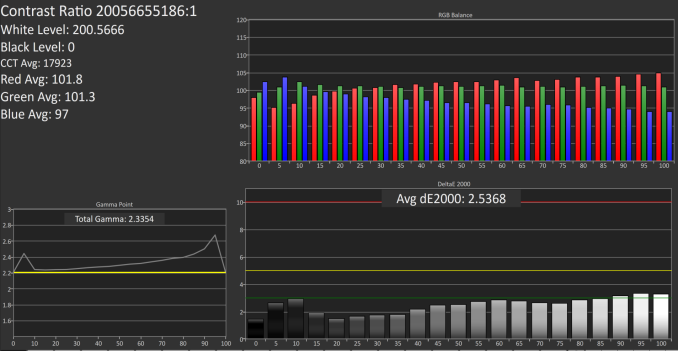
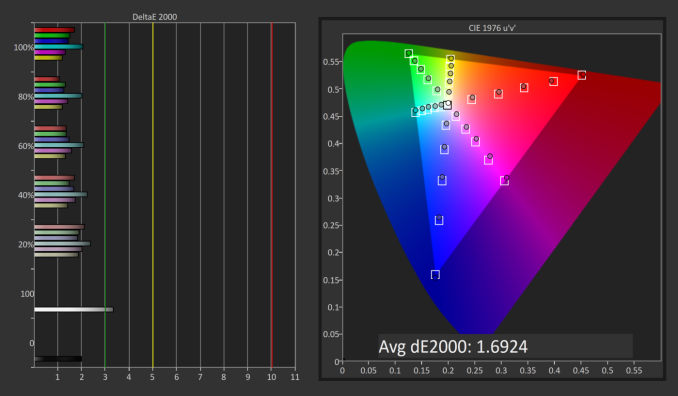
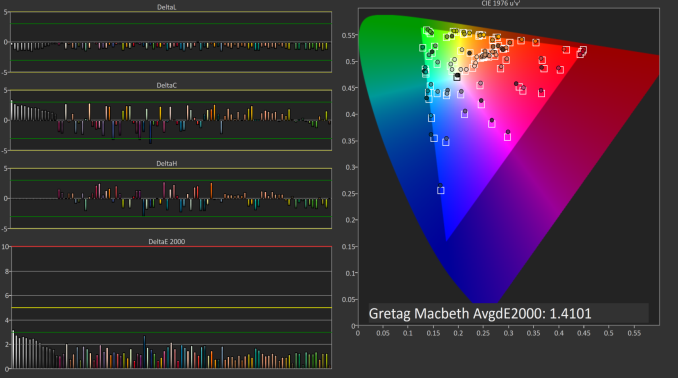
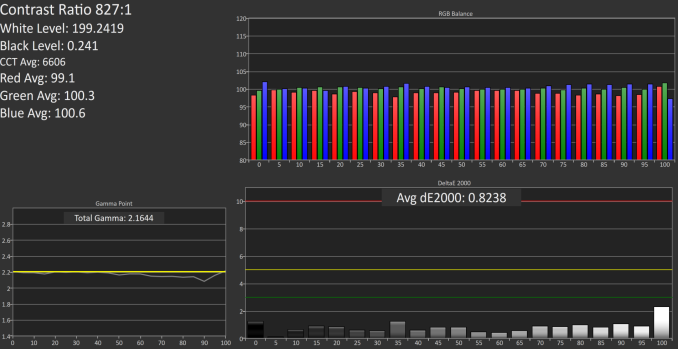
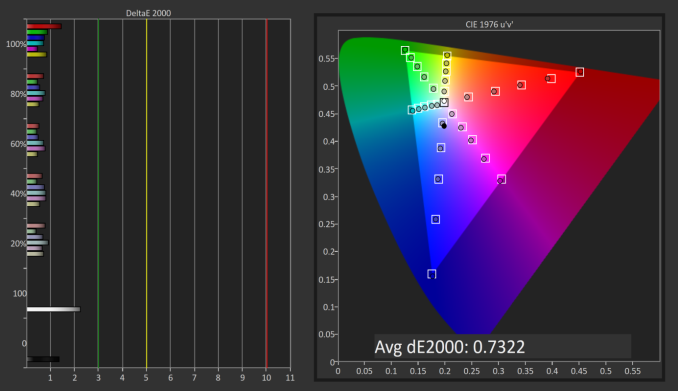
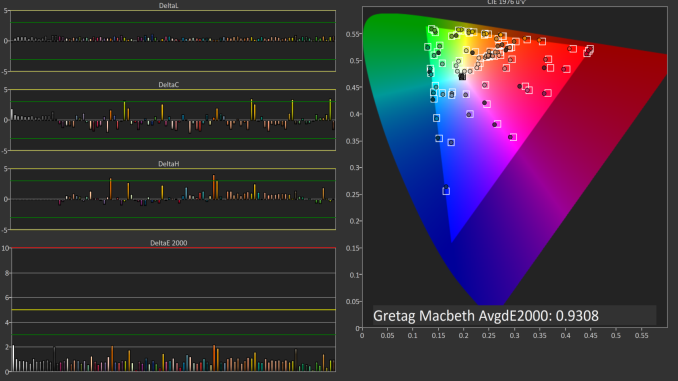
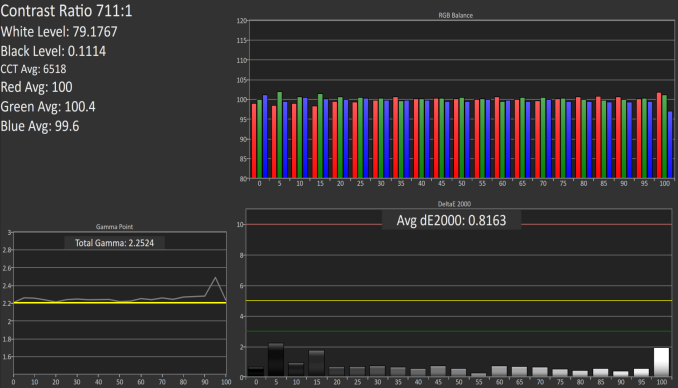
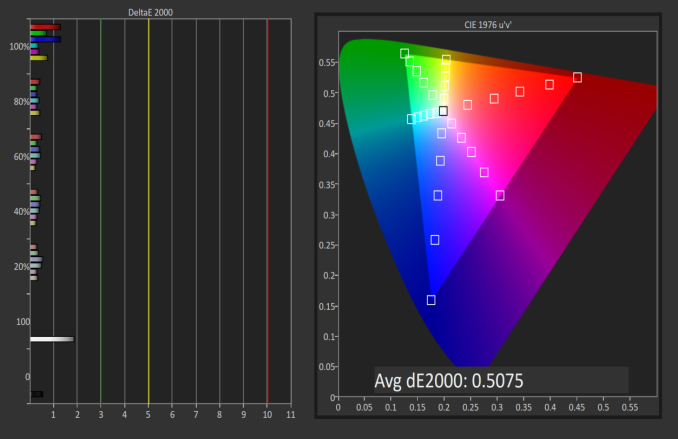
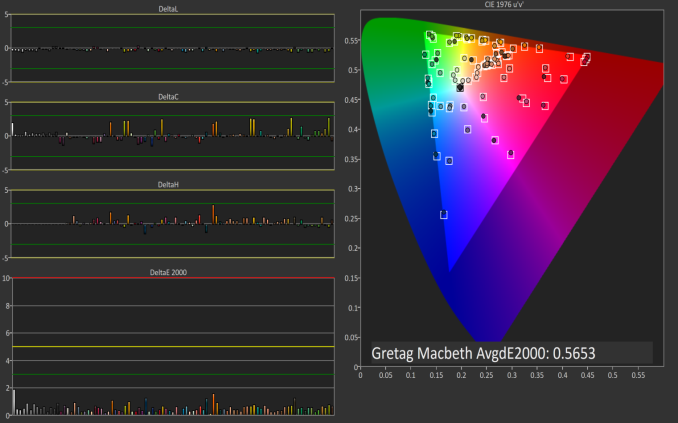










92 Comments
View All Comments
jbrizz - Tuesday, December 22, 2015 - link
I totally agree. There is no point in pushing technology any further beyond this point. In fact, I might take away all but 640k of your RAM, why would anyone need more than that?Spunjji - Tuesday, December 22, 2015 - link
I don't know if you're using Windows 10 or not, but the DPI scaling is getting very good now.hammer256 - Tuesday, December 22, 2015 - link
Frankly, at ~24" viewing distance, 2560x1440 on 27" works pretty excellently for 1:1. I don't want to sit any closer to my monitors, not comfortable for the eyes. If I was going for 4K, I would want something like a 37". Which is huge. And 3 of them? I'll need a bigger desk. I guess with 4K I can make do with just 2 monitors, but once you go triple monitors, you don't go back ;)geok1ng - Thursday, January 7, 2016 - link
Actually, even 32" is way below the confortable reading limit. Most users complain of the PPI on 24" 256x1440 screens, which have a PPI similar to an hypothetical 34" 4k screen. reading at 1:1 4k is impossible for most users even at the 32" monitors. you can not compare with smartphones screens, because the viewing diustance for smartphones is smaller.MatthiasP - Tuesday, December 22, 2015 - link
It's almost double the price of a 4K display, connects via stopgap MST and doesn't bring much improvement in perceived details at arm's length viewing distance over 4K@27".We 4K display owners are still fine, thank you very much.
quickbunnie - Wednesday, December 30, 2015 - link
Problem is, can you even see 5k resolution at 27 inches and a normal viewing distance? You need to be only 21 inches away for a 4k pixel to take up 1 arc minute, nominally considered the limit of average human vision. At this distance, a 27" display takes up 58.5 degrees of you field of vision, which is very large.Even when editing pixel perfect 1:1 4k video, I'm not sure most people will actually be able to see the extra pixels. If you scoot in and look real close, for sure (which I'm sure many professionals do), but I would say 5k does not automatically mean better for most use cases.
LisaValentin3 - Thursday, December 31, 2015 - link
Prima di poter determinare ciò che schermo è giusto per voi, dobbiamo sapere la vostra situazione. Che cosa hai intenzione di utilizzare il portatile per?<a href=http://schermiportatili.it/hp.html>schermo hp</a>
<a href=http://schermiportatili.it/samsung.html>schermo samsung</a>
gonzo98x - Tuesday, December 22, 2015 - link
What's the deal with the price of this monitor when Samsung can squeeze a 4k display into a 6 inch screen and sell it for far less?Doesn't it take a higher level of specialized technology to cram a 4k resolution into such a small display? To me that would mean a phone display should be more expensive or in the case a 27" monitor should cost less.
So where does the cost come from? Or is this simply another example of setting the price for something 'because they can'. We expect it to be expensive so it is expensive?
I'd love to see a teardown and bill of goods for a monitor such as this.
Insert <thesepricesaretoodamnhigh.jpg>
TheStu - Tuesday, December 22, 2015 - link
I imagine it has something to do with the economies of scale. Whoever is making this panel for HP, they're probably looking at less than 100,000 sales (especially if it is NOT the same panel that's in the 27" iMac). Samsung is going to sell tens of millions of their phone displays.bryanlarsen - Tuesday, December 22, 2015 - link
A 6" display has an area of 15 in^2. A 27" display has an area of over 300 in^2. 20x in size, ~20x in cost, where's the disparity?